Core Petrophysical Properties
Lithofacies, Permeability, Porosity
Lithofacies and early diagenesis are major controls on permeability (k) and porosity (![]() ) despite complex diagenetic overprinting k and
) despite complex diagenetic overprinting k and ![]() decrease with decreasing grain/mold size from packstone to mudstone (a trend exhibited by other Mississippian carbonates). Figure 1
decrease with decreasing grain/mold size from packstone to mudstone (a trend exhibited by other Mississippian carbonates). Figure 1
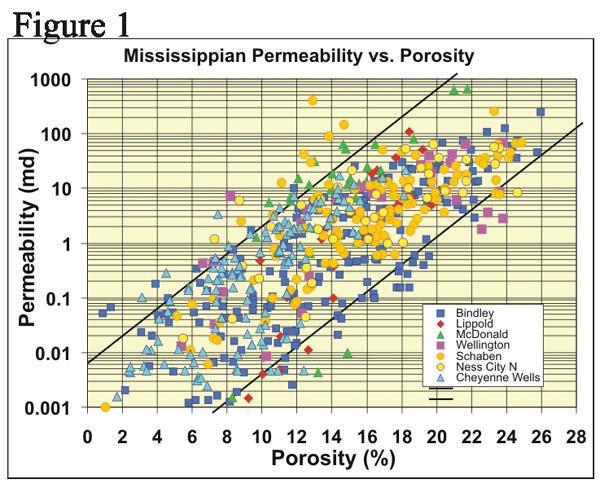
The permeability-porosity trends for all lithofacies for the Kansas Mississippian and Cheyenne Wells are approximately bounded within 2.5 orders of magnitude by trendlines defined by:

Between these bounding trends each lithofacies exhibits a generally unique range of k and ![]() which together define a continuous trend, with k decreasing with decreasing grain/mold size for any given porosity. At Cheyenne Wells each lithofacies generally exhibits a unique sub-parallel trend to the general trend:
which together define a continuous trend, with k decreasing with decreasing grain/mold size for any given porosity. At Cheyenne Wells each lithofacies generally exhibits a unique sub-parallel trend to the general trend:
![]()
where A=3x10-6x3Lith and B =~3.45, and where Lith represents an integer classification of the lithfacies (0-mudstone, 1-mud-wacketone, 2-wackestone, 3-wacke-packstone, 4-packstone, 5- pack-grainstone). Figure 2
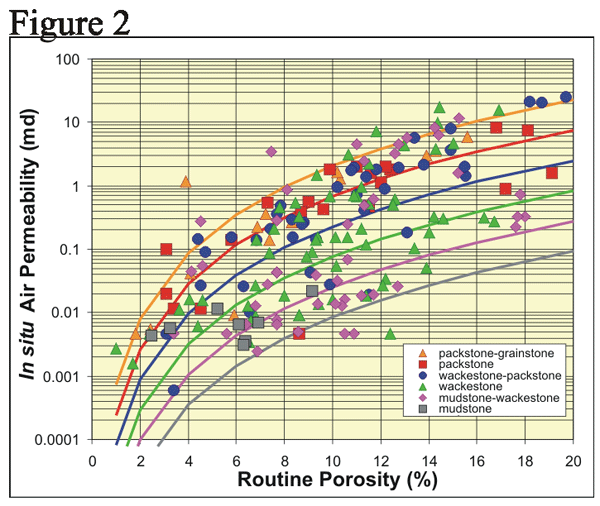
Comparison of full-diameter and plug permeability-porosity trends indicates that fracturing plays little role in permeability at this scale. Differences between plug and full-diameter permeabilities reflect effects of confining stress difference. Figures 3 and 4
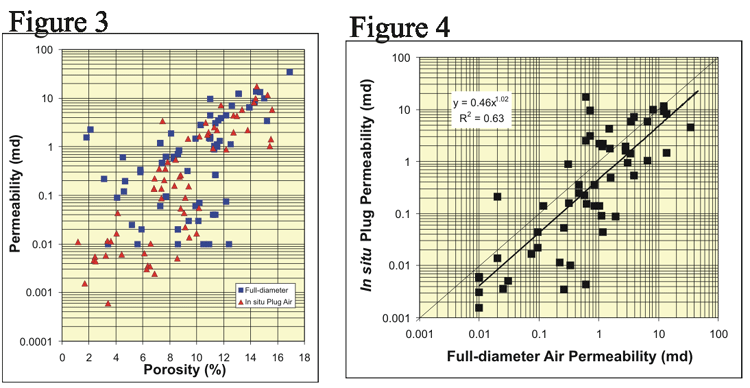
Permeability values for the CA 3 and K 4 wells are similar at any given porosity except for some mudstone-wackestone and wackestone samples. The significantly better permeabilities of the CA 3 samples may result from improved moldic porosity connectivity. This is still under investigation.
Figure 5 (K 4 has lighter colored symbols and CA 3 has darker symbols on graph).
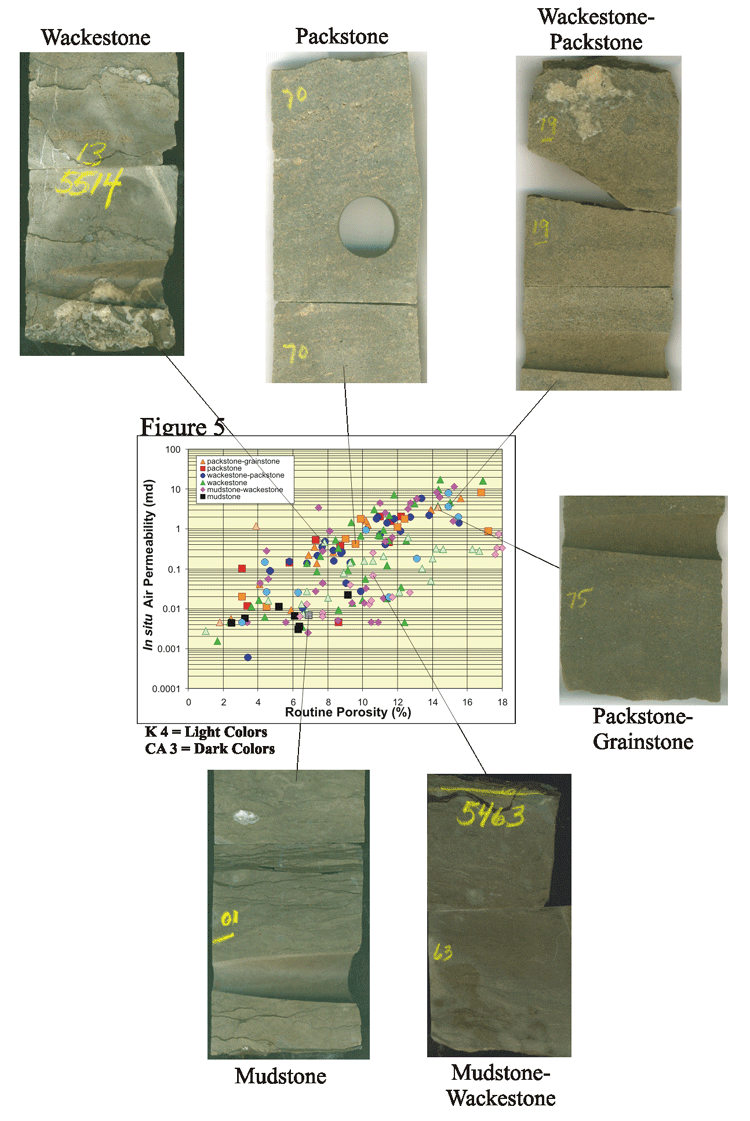
Permeability and Pore Throats
Though permeability is shown correlated with porosity, variables that control permeability in Mississippian rocks include pore throat size and distribution, grain size distribution, moldic pore size and packing, and moldic pore connectivity. Porosity is only one of the variables controlling permeability and bivariate correlation therefore relies on the correlation between porosity and the other controlling variables. A crossplot of permeability and principal pore throat diameter (PPTD) illustrates the control PPTD exerts on permeability. Two Cheyenne Wells samples from the CA 3, a mudstone-wackestone (k=0.0025 md in situ air, k = 0.0007 md in situ Klinkenberg) and packstone ((k=5.67 md in situ air, k = 4.66 md in situ Klinkenberg), exhibit PPTD consistent with other other rocks including Mississippian rocks.
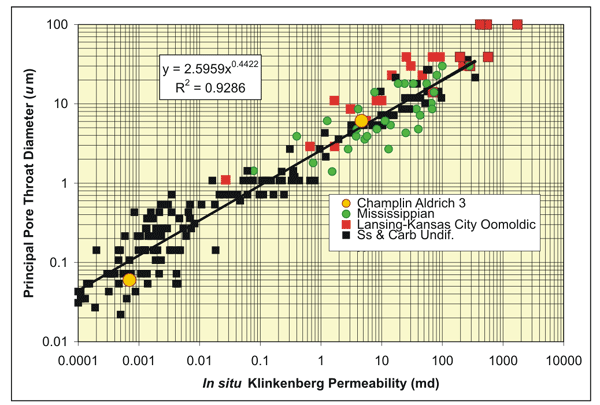
Capillary Pressure
Capillary pressures and corresponding water saturations (Sw) vary among lithofacies, and with porosity/permeability and gas column height. Threshold entry pressures and corresponding heights above free water level are well correlated with permeability and consistent with the relationship between pore throat size and permeability.
Capillary pressure curves for a mudstone-wackestone and packstone illustrate approximate upper and lower limits for rocks from the Cheyenne Wells field. Permeable packstones exhibit sufficiently low entry pressure (and equivalent oil column height). These pressures are insufficient for low permeability mudstones, which are water saturated (Sw=100%).
Pore throat size distributions are consistent with unimodal distribution indicating that moldic porosity is only accessed through matrix porosity.
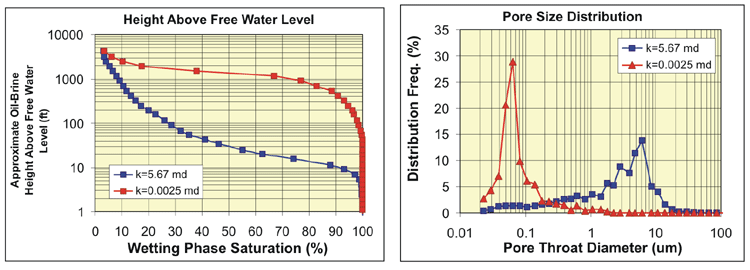
http://www.kgs.ku.edu/PRS/publication/2006/2006-14/p2-02.html
Last Modified May 2006